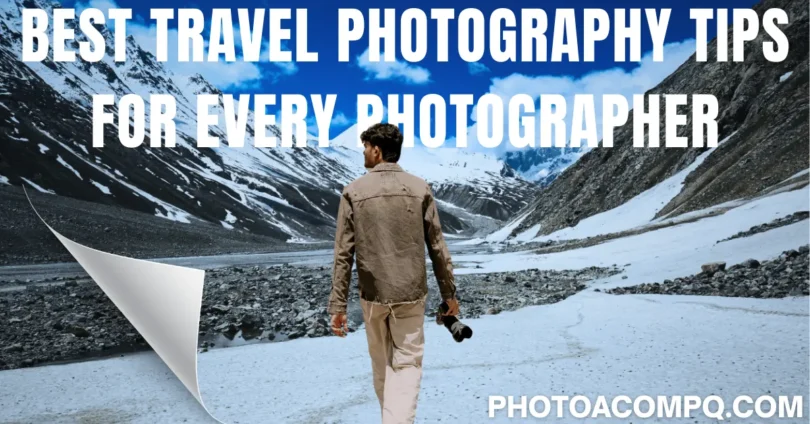Best Travel Photography is all about capturing these moments so you can remember them forever. Whether it is a stunning mountain view, a busy city street, or local people and culture, travel photography lets you tell a story through your photos.
With the right camera, tips, and techniques, anyone can learn how to take amazing travel pictures. In this article, we will guide you step by step to improve your travel photography skills and create photos that truly stand out.
Choosing the Right Camera for Travel
The camera you choose is very important for travel photography. There are different types of cameras, and each has its own benefits.
- DSLR Cameras: These are popular because of their high quality and flexibility. You can change lenses according to the type of photo you want. They are slightly heavy, but they give professional results.
- Mirrorless Cameras: Lighter than DSLRs, these cameras are perfect for travelers who don’t want to carry heavy equipment. They also offer excellent photo quality and fast shooting speeds.
- Smartphones: Today, smartphones can take amazing pictures. They are light and easy to carry. With the right apps and editing tools, your smartphone photos can look professional.
Tips for Choosing a Camera:
- Consider your travel style do you need light gear or high-quality photos?
- Think about your budget DSLRs and mirrorless cameras are expensive, smartphones are affordable.
- Check for portability lighter cameras are easier to carry on long trips.
Essential Photography Gear for Travelers
Apart from a camera, some tools can make your travel photography much better.
- Lenses: Wide-angle lenses are great for landscapes. Zoom lenses help you capture distant subjects. Prime lenses give sharp, high-quality images.
- Tripods: A tripod is useful for night photography, long exposures, or group photos.
- Gimbals: These help stabilize your camera or smartphone for smooth videos.
- Camera Bags: A good bag keeps your camera and lenses safe and organized.
Packing Tips:
- Always carry extra batteries and memory cards.
- Keep a lens cloth to clean your lenses.
- Pack your gear in a waterproof bag if you are visiting rainy or wet areas.
Understanding Light and Timing
Light is the most important part of photography. Good light can make ordinary scenes look magical.
- Golden Hour: This is the hour after sunrise and before sunset. Photos taken during this time have a warm and soft light.
- Blue Hour: The time just before sunrise or after sunset. It gives a cool and calm effect to your photos.
- Avoid Harsh Noon Light: Midday sun creates harsh shadows. Try to find shade or adjust your camera settings.
Tips for Different Weather:
- Cloudy days are perfect for soft, even light.
- Rainy weather adds drama to photos but protect your gear.
- Nighttime photography requires longer exposure or higher ISO settings.
Composition Techniques for Stunning Photos
Composition is about arranging elements in your photo to make it attractive and interesting.
- Rule of Thirds: Imagine dividing your photo into 9 equal parts. Place important subjects along these lines or at the intersections.
- Leading Lines: Use roads, rivers, or bridges to lead the viewer’s eyes to the main subject.
- Framing: Use natural frames like windows, arches, or trees to surround your subject.
- Perspective: Take photos from different angles low, high, or side to make them unique.
Tips for Landscapes vs. Cityscapes:
- Landscapes: Focus on wide shots and include foreground, middle ground, and background.
- Cityscapes: Capture streets, buildings, and people. Look for symmetry and patterns.
Capturing Local Culture and People
Travel photography is not only about places; it’s also about people and culture.
- Respect Privacy: Always ask permission before taking someone’s photo.
- Tell a Story: Try to capture people doing their daily activities, festivals, or traditional work.
- Use Natural Poses: Candid shots look natural and more interesting.
Ethical Considerations:
- Avoid disturbing or offending locals.
- Be sensitive to cultural traditions.
- Do not take photos in restricted areas.
Travel Photography Editing Tips
Editing helps enhance your photos and gives them a professional look.
- Basic Adjustments: Adjust brightness, contrast, saturation, and sharpness.
- Crop and Straighten: Remove unwanted parts and keep the horizon straight.
- Use Presets and Filters: These help maintain a consistent style across your photos.
Popular Editing Tools:
- Lightroom: Great for color correction and overall editing.
- Photoshop: Useful for advanced editing and removing objects.
- Snapseed: Free and easy-to-use mobile editing app.
Tips for Safe and Smart Travel Photography
Travel photography can be fun, but safety is important.
- Protect Your Gear: Use straps and padded bags to avoid damage.
- Backup Your Photos: Always save your photos to cloud storage or memory cards.
- Stay Alert: Be careful in crowded or unfamiliar places.
- Travel Insurance: Consider insurance for expensive equipment.
Sharing Your Travel Photos
Sharing your photos helps you inspire others and build a community.
- Platforms: Instagram, Facebook, Pinterest, and travel blogs are great for sharing photos.
- Captions: Write interesting stories or details about your photos.
- Engage Audience: Respond to comments and share tips with followers.
Tips for Online Sharing:
- Use hashtags to reach more people.
- Post consistently to keep your audience engaged.
- Create a portfolio to show your best work.
Common Mistakes to Avoid in Travel Photography
Even experienced photographers make mistakes. Avoiding these can improve your photos:
- Overpacking Gear: Heavy bags can slow you down. Carry only what you need.
- Ignoring Light: Bad lighting can ruin even the best composition.
- Not Respecting Culture: Always ask before photographing people or sacred places.
- Rushing Shots: Take time to frame and focus properly.
- Overediting Photos: Too many filters make photos look unnatural.
Common FAQs About Best Travel Photography
Some faqs of Best Travel Photography:
1. What is the best camera for travel photography?
A mirrorless camera or a DSLR is great, but smartphones with good cameras also work well.
2. How can I improve my travel photography?
Practice often, learn composition techniques, and understand lighting.
3. Should I edit my travel photos?
Yes, light editing improves quality, but avoid overediting.
4. Can I do travel photography with a smartphone?
Absolutely, Many travel photographers use smartphones successfully.
5. What is the golden hour in photography?
It is the time after sunrise or before sunset when light is soft and warm.
6. How can I capture local culture respectfully?
Ask for permission, observe traditions, and be polite while photographing.
7. Should I carry all camera gear on trips?
Carry only essential gear to avoid heavy and difficult travel.
8. How do I protect my camera while traveling?
Use padded bags, camera straps, and keep it away from water and dust.
9. Can travel photography make money?
Yes, through stock photography, blogging, social media, and client projects.
10. How do I share my travel photos online?
Use Instagram, blogs, or photography platforms with proper captions and hashtags.
Conclusion
Travel photography is a journey of learning and exploration. By choosing the right camera, understanding light, mastering composition, and respecting local culture, you can create stunning photos.
Practice regularly, experiment with new techniques, and don’t be afraid to make mistakes. Remember, every travel photo tells a story, and with dedication, your photos can inspire and captivate others.


